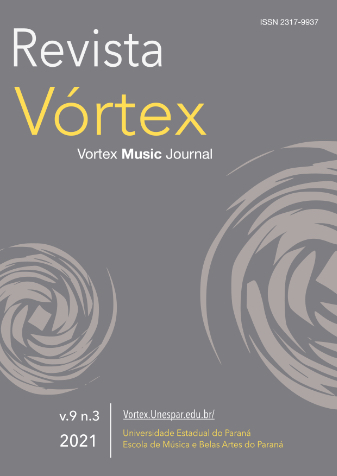Application of the Aesthetic of Guqin (古琴) for Contemporary Music Composition
DOI:
https://doi.org/10.33871/23179937.2021.9.3.2Keywords:
Chinese Music, Guqin, Contemporary Music, Compositional Techniques, Music Composition, Aesthetic, Chinese ArtAbstract
The purpose of this research is to discover the application of aesthetic approach, performing technique and playing style of Guqin for contemporary music composition. Mentioned in documents dating from two millennia, Guqin is one of the oldest Chinese solo instruments. Moreover, Guqin music often is based on senza misurato (散板, without tempo) and it focuses on changing the colours of several notes, occasionally even a single note. This is accomplished by using an open string note (散音), stopped string note (按音), harmonic note (泛音) as well as four main ornaments (綽注吟猱) to achieve the poetic mood. This aesthetic is in direct contrast to western homophonic structure. These characteristic effects offer an attractive potential for their application to new compositional techniques and approach to contemporary music writing. This research will provide valuable information regarding employment of the Guqin's philosophy for music composition.
Downloads
References
CHUN YAN, Tse; LAM, Shui Fong. Translation of The Xishan Treatise on the Aesthetics of Qin Music by Xu Shangying. Renditions, no.83 Hong Kong: Hong Kong Chinese University press, 2015.
CHUN YAN, Tse. The Inconspicuous Acceleration in Qin Music: An Insider’s View with Validation by a Perceptive Study, Asian Musciligy 11:29-41, 2007.
CHUN YAN, Tse. Exploring the Secluded: A Collection of Academic Papers, Compositions and Reconstructions on the Qin by Tse Chun Yan. Chongqing Publishing Group, 2016.
CLAYTON, Martin R. L. Free Rhythm: Ethnomusicology and the Study of Music without Metre. Cambridge University Press, 1996.
HAYASHI, Kenzō. Dūnhuáng Pípápǔ De Jiědú Yánjiū 敦煌琵琶谱的解读研究 (The research of Tun-huang Musical Scores of pipa). Pān Huáisù (trans). Shanghai: Shanghai Yinyue Chubanshe, 1957.
KOSTKA, Stefan. (2006) Materials and Techniques of Twenty Century Music. New Jersey: Upper Saddle River
LOUDOVÁ, Ivana. Moderní Notace a Její Interpretace. Prague: Akademie Múzických umění v Praze, Hudební Fakulta, 1998.
MESSIAEN, Olivier. The Technique of My Musical Language. John Satterf ield Translation (1956). Paris: A. Leduc
TSCHAIKOV, Basil; PENYEH, Tsao. (1998) Music Performance vol. 2. Singapore: The Harwood Academic Publisher Imprint
VAN GULIK, Robert. The Lore of the Chinese Lute. Tokyo: Sophia University, 1940.
WIKIPEDIA. Guqin. Available at: https://en.wikipedia.org/wiki/Guqin. Access on: 25 jan. 2019
WIKIPEDIA. Guzheng. Available at: https://en.wikipedia.org/wiki/Guzheng. Access on: 25 jan. 2019
WONG, Chuen-Fung. Listening to Chinese Music. Hong Kong: Commercial Press, 2010.
YU SIU WAH. Appreciation of Chinese Music, 26 talks. Hong Kong: Radio 5, RTHK, 2006.
Downloads
Published
How to Cite
Issue
Section
License
Copyright (c) 2022 Barry Yuk Bun Wan

This work is licensed under a Creative Commons Attribution 4.0 International License.
Autores mantêm os direitos autorais e concedem à revista o direito de primeira publicação, com o trabalho simultaneamente licenciado sob a Licença Creative Commons Attribution que permite o compartilhamento do trabalho com reconhecimento da autoria e publicação inicial nesta revista.






